Draw Cubes and Boxes With Easy Step by Step
How to draw a cube: iii unlike ways and perspectives
How to depict a cube: learn 3 common ways to show iii dimensional cube on a flat newspaper - unproblematic 3D view and 1 indicate and two point perspective.

The offset way how to describe a cube is a simple view. This is an easy way to suggest space and depict a three-dimensional shape on a flat paper.
Although a fleck harder, learning how to draw a cube in 1 point perspective makes it looks more realistic – like a real object in space.
A cube in 2 point perspective is a very dynamic and exaggerated view, which really makes the flat drawing pop out to the third dimension.
pencil
,
eraser
,
color pencils
drawing newspaper
or
sketch book
Honey drawing? Never miss a tutorial!
How to describe a 3D cube in elementary cabinet view
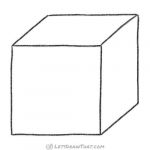
Our commencement cube is fatigued in a simple 3D cabinet view. This is an easy way to advise depth and describe a three-dimensional shape on flat paper. Let's get into it!
3D cube drawing
Pace 1: Draw a square

Outset drawing a cube with a simple apartment square. This will be the front side of your cube. In this tutorial you will surely get some good exercise cartoon straight lines. Brand all the sides of the foursquare the aforementioned length, and endeavour to keep the right angles every bit direct as y'all tin can!
Stride ii: Add the side edges

Add three lines, 1 in each of the top and right hand corners. Make all the lines the aforementioned length again. Yous can play with the bending at which you draw the lines. We have drawn the lines at a roughly 45-degree angle hither. That gives u.s. the most typical view of the cube, where y'all can run across both the top and correct side. But turn the side lines more up, or to the side (flat) – and y'all will get very different views of the cube. Merely make certain that all lines are the same length and at the same angle.
Step 3: Depict the rear edges to terminate the cube

Complete the cube past adding the last two edges. These are, again, the same length as our original square. One runs vertical (left to right), and one horizontal (tiptop to bottom).
Explore: How to draw a cube from different angles
Pinnacle-right view

Now that y'all know how to describe a cube in the basic view, effort playing with unlike angles and views. Here is the complete cube y'all accept merely fatigued. Since nosotros have extended the angled lines up and to the right, yous tin can see the top and right manus sides of the cube.
Summit-left view
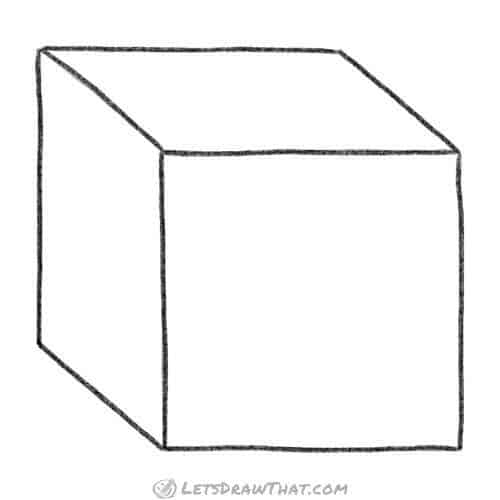
But if you choose to extend the angled lines up and to the left, you flip the cube and then that you encounter the top and left hand sides of the cube. Notice that the bottom side line is now coming out from the other side of the cube likewise.
Bottom-left view
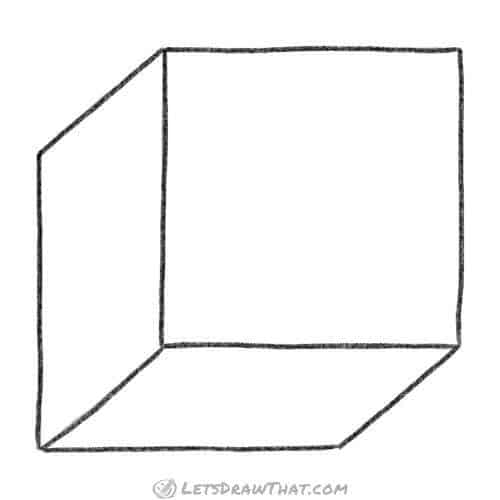
You lot can likewise draw the sides pointing downwardly, and go a view in which we see the cube from the bottom up. And if you want to use your new cube-drawing skill for a real drawing, jump straight to "How to depict a robot" tutorial.
Like this tutorial? Share it with others:
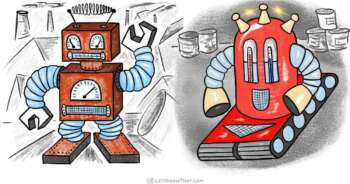
How to depict a cube in i point perspective

A slightly more advanced way to draw a cube is with 1 bespeak perspective. The resulting cube is very similar to the unproblematic way we have used above, just slightly more squished. Although a bit harder to depict, the result looks more than realistic – like a real object in space. That is what perspective does – it is a way to show space on the flat paper. Let'due south get drawing!
Drawing a one point perspective cube
Step 1: Draw a square and the vanishing signal
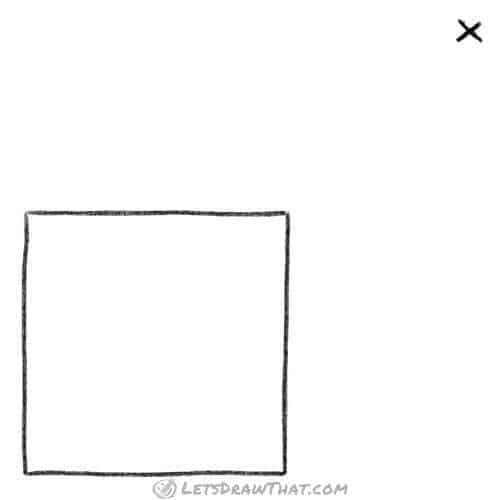
Start as before with the front square face of our cube. Next, mark the betoken into which our perspective will merge. This is called the vanishing point. Here nosotros have put it in the top right corner, that way nosotros will get a view which is similar to the one we accept drawn above. Once you have drawn a cube the way we have shown hither, play with the placement of your vanishing signal. Moving it farther down or to the left will give you a very dissimilar view of the cube.
Step 2: Draw the perspective guidelines
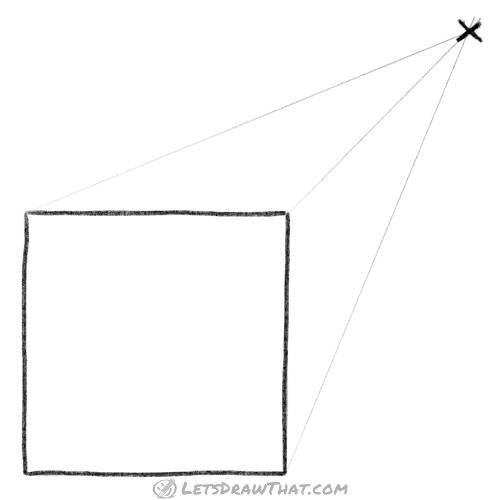
Next, draw the perspective guidelines. They all commencement at the top and right corners of our front face square, and merge into the vanishing point. (It is called the vanishing point considering objects get smaller the closer they become to the bespeak. At the vanishing indicate objects would exist so small that they vanished.) You tin can use a ruler to draw your lines similar nosotros did, if y'all have one on hand. Information technology makes the job a bit easier. Too, depict the lines just lightly – they are there only for guidance and nosotros volition erase them afterwards.
Step 3: Draw the far edges of the cube
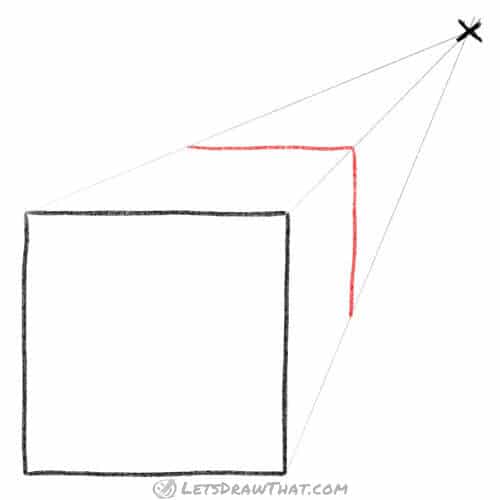
With the guidelines in place, draw the far edges of the cube. Both edges kickoff and cease at the perspective guidelines. Beginning, draw the elevation far edge – parallel to (in the same direction as) the horizontal pinnacle line of the front cube confront. Then depict the vertical (elevation-down) far edge – again, it follows the management of the top-downwards side of the forepart face. Yeah, hither are some fancy words you take just learned:
"Parallel" lines are two lines going in the same management.
A "vertical" line is a line going from top downwards.
A "horizontal" line is a line going from left to right, same as the "horizon". And "horizon" is the line where the earth meets the heaven, if you look far into altitude – the line that goes flat left to right.
Step 4: Depict the side edges to complete the cube

Afterwards a short linguistic detour, we're back to drawing a cube. This is an piece of cake stride – just outline the perspective guidelines between the front and rear confront of our cube to complete the cartoon.
How to describe a cube in one point perspective: finished drawing
Finished cube in one point perspective
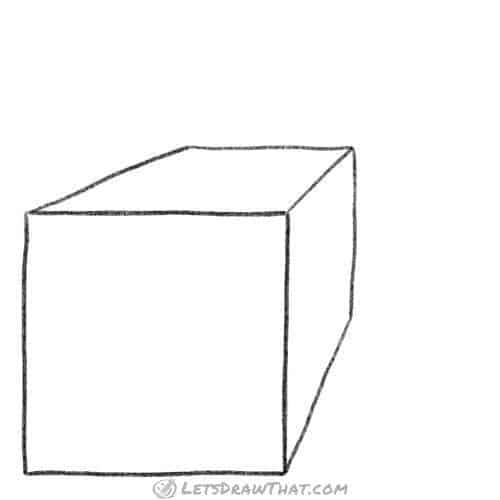
The final pace is to erase the vanishing signal and the guidelines you drew before. As yous can see, the resulting cube cartoon is very similar to the simple way nosotros take used to a higher place, just slightly more squished. But that is what makes it look more realistic, similar a real cube in space, although it is fatigued on a flat newspaper. And if you are up for a challenge, practice one-betoken perspective on drawing Halloween pumpkin faces!
Like this tutorial? Share it with others:

Cartoon pumpkin faces for Halloween
Drawing pumpkin faces for Halloween: 3 smashing looking pumpkin faces and a simple perspective tutorial to add depth and interest to your cartoon.
How to draw a cube in two point perspective

The 3rd way how to draw a cube is using ii-point perspective. Information technology uses similar guidelines to the 1 betoken perspective in a higher place, only these merge into two dissimilar vanishing points. The result is a very dynamic and exaggerated view of the cube that actually pops out from the flat cartoon to the third dimension.
Drawing two point perspective cube
Stride i: Draw the two vanishing points
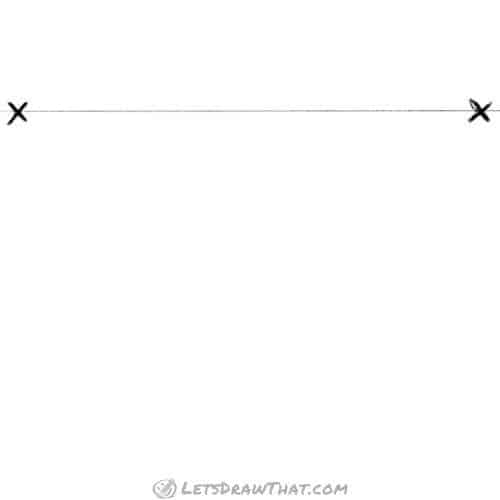
Nosotros start simple by mark the two vanishing points. Draw a horizontal line nearly the top of your sail of paper. Then marker two points on the line near the edges, every bit far every bit possible from 1 another. There! Now, every bit usual, this is your drawing, and y'all tin can place the line and points wherever yous like. Where we have placed them for now will brand the explanation easier, since all the guidelines volition be nicely visible, so for this drawing delight follow along. The closer together you put the points, the more squished and less natural will the cube look, and then marking the points as far apart as possible looks better. Placing the line upward, downwards or in the middle of the paper will give you dissimilar views of the cube – superlative, bottom or a level view. So one time y'all have drawn this cube, go and experiment with your own signal placement!
Step 2: Draw the front edge of the cube
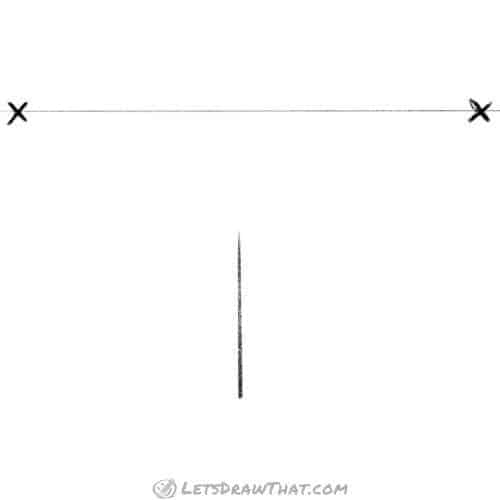
Another simple step: Draw a straight vertical line – this will exist the front edge of the cube. Place the line in the middle of the paper, with a gap from the horizontal guideline. If you place the line more than to the left, you volition encounter more of the right side of the cube. Draw the line to the correct to encounter more of the left side. Put the line further upwards, and you volition see less of the tiptop of the cube. And if you draw the line beyond the horizontal guideline, and you will see neither elevation nor bottom of the cube. See how information technology works? Try it out once we are done hither! Simply to follow forth with this cartoon, identify the cube edge in the centre with a gap from the horizon.
Step three: Draw the perspective guidelines

Now lightly describe four guidelines. Two from the top terminate of our cube edge, each connected to ane of the vanishing points. And then two more from the bottom of the border, again going dorsum to the vanishing points. Draw these straight lines with a ruler, if you take one handy.
Footstep 4: Draw the outer edges of the cube
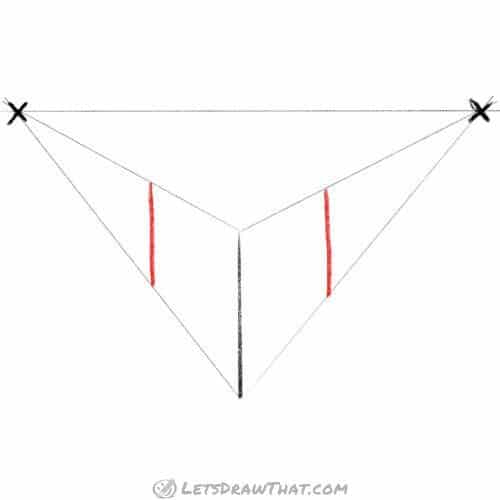
Adjacent draw two parallel vertical lines, one on each side of the outset front end edge. These are the left and correct edges of the cube in two point perspective.
Footstep 5: Depict the perspective guidelines from the outer edges

At present that we have the vertical edges of our cube, draw two more perspective guidelines. These over again start at the top cease of our vertical cube border. The one from the right border goes to the left perspective point. The 1 from left edge goes to the right. That way the lines are crossing marks out the elevation side of the cube. It is much easier to see it on the motion-picture show that to explain it in words.
Step 6: Draw a cube from the guidelines

In this step, we just outline the right parts of our guidelines to complete the cube drawing. Starting time outline the bottom edge between the vertical lines. And so outline the top side of the cube – 4 edges marked out by the perspective guidelines.
How to draw a cube in 2 point perspective: finished drawing
Finished cube in two point perspective

This is the final step. Erase all the guidelines to clean up your drawing. We have too added a horizontal line "behind" our cube – that suggests that the cube is laying on a table or some other surface. That is all – now you can draw a cube in 2 point perspective. Every bit you tin can see, the result is very dynamic and expressive. If yous want the bottom corner to stick out less, and go a bit more than of a natural view, just draw the center cube border (the very first vertical thick line) further up and closer to the horizon. Remember all the options for starting your cartoon from the footstep 2?
Like this tutorial? Share it with others:

mcclemenshisherear97.blogspot.com
Source: https://letsdrawthat.com/how-to-draw-a-cube/
0 Response to "Draw Cubes and Boxes With Easy Step by Step"
Post a Comment